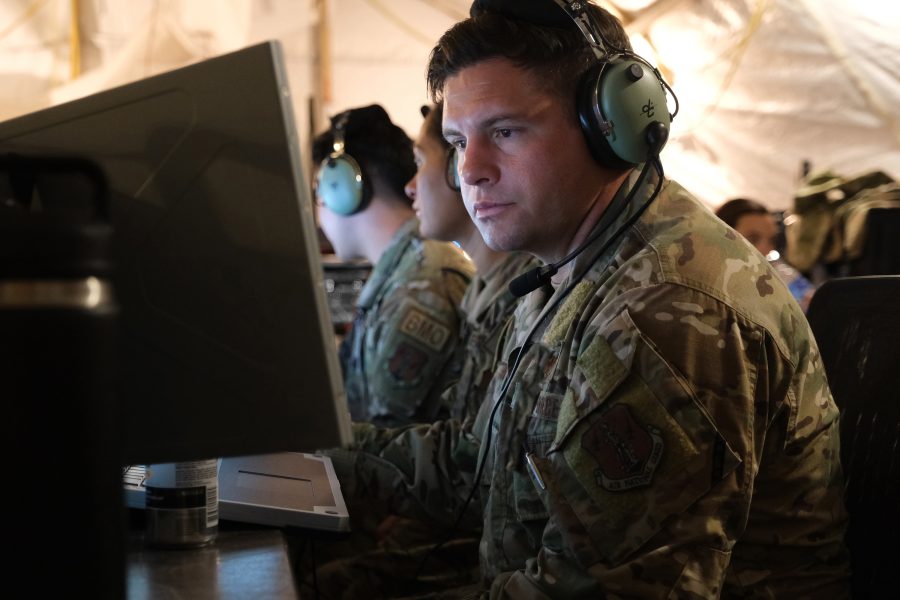NATIONAL HARBOR, Md.—The Air Force should place greater emphasis on exercising and training for long range kill chains right now, rather than waiting for new technologies to make things easier, industry executives and former Air Force officers said at AFA’s Air, Space & Cyber Conference on Sept 24.
In a large-scale war, current operational concepts like centralized command and control are unlikely to survive contact with the enemy, said retired Air Force Col. Jon “BigDogg” Rhone. Rhone, who left the service in 2019 as commander of the 505th Test & Evaluation Group, is now a command and control strategist with SAIC.
Quoting boxer and “philosopher” Mike Tyson, Rhone warned: “‘Everyone’s got a plan, until they get punched in the face.’”
“The first time that we get punched in the face trying to implement long range kill chains, we will have to consider if that construct of centrally controlling those decisions is working,” he said during a panel discussion. In reality, U.S. forces would likely have to rely on battle managers at the edge to make decisions, rather than looking back to the rear echelon, he said. “We plan this thing, but we get punched in the face and the [air operations center] is taken off the grid. Now somebody else has to make that decision.”
Decision-makers at the edge will need information, which means connectivity, added Michael Dupasquier, vice president of airborne systems for General Dynamics. “We can’t just rely on the sensors on board those platforms to give the operator the information that’s needed,” he explained. The data will have to be collated and fused from multiple sensors, and then moved to where it was needed.
“It’s after we get punched in the face that some of the data processing is going to be moving to the edge,” Dupasquier said. “It is about getting the right data to the right place at the right time, so that the right decision can be made.”
That will be challenging, he acknowledged. “We’re going to be aggregating data from multiple different platforms that are across multiple different security levels that historically may not have shared data organically … Whether that’s from joint partners in the multi-domain operation, or with coalition partners so that data can get to the right platform,” Dupasquier said.
But such new operational concepts need to be rehearsed over and over again now to create “muscle memory,” said retired Gen. Jeffrey “Cobra” Harrigian, now vice president for strategy and business development at Lockheed Martin’s famed Skunk Works division.
“If we don’t repeatedly try it in the Pacific, in Europe, you’re not going to have the muscle memory to do it day one, right? Because [in a peer conflict] this is probably going to happen early as part of any operational activity. And so if you have not done this repeatedly, it’s going to be really challenging to do it on day one or day two of the war,” Harrigan said.
That training has to begin immediately, argued Erich Hernandez-Baquero, vice president for space ISR at Raytheon. “One of the concerns I have is, we tend to look at this as a future problem. We’re going to wait until we get the new sensors in, or we’re going to wait until we get the new effectors in.”
Instead, U.S. forces need to be trying to construct long range kill chains right now. “We can start operating that way today, with the sensors that we have and the weapons that we have. And I think we need to really get after rehearsing how we operate differently now,” Hernandez-Baquero said.
Rehearsing means decomposing the kill chain into its component parts and training on every element under current conditions, Hernandez-Baquero added, “We have to pull the entire kill chain through in the way that we exercise and test. … We need to wire everything now with the sensors and the effectors that we have now, because the fight could break out tonight, right? And so we need to be ready with the capabilities that we have now,” he said.
But current training and exercise regimens don’t really test long range kill chains to the point of failure, said Rhone. “We’ve all, I think, gone through the weapon school, or Red Flag [exercise] where we don’t train to failure,” he said.
In a real-world exercise, he explained later, an asset like an F-35 might be notionally shot down, and a debrief and remedial training prepared, but the shoot-down would be considered “white card input” and the actual plane would be allowed to continue to take part in the exercise.
“I understand why that happens,” Rhone told Air and Space Forces Magazine in a post-panel interview. “A lot of money is spent on these things, on getting everyone out there. You don’t want to have them fly for two minutes and they go land.”
But the result, he added, is “it doesn’t force us to figure out, now, what do we do when our most exquisite assets are gone, off the board? We never have to exercise those particular brain muscles. We don’t get the experience of that. We don’t get the pain of it.” The risk, he said, was that the first time the force being trained like that would experience that pain was in combat.
“If the first time that we fail at this is when the blood is flowing, I think we’ve probably done the country a disservice,” he warned.


